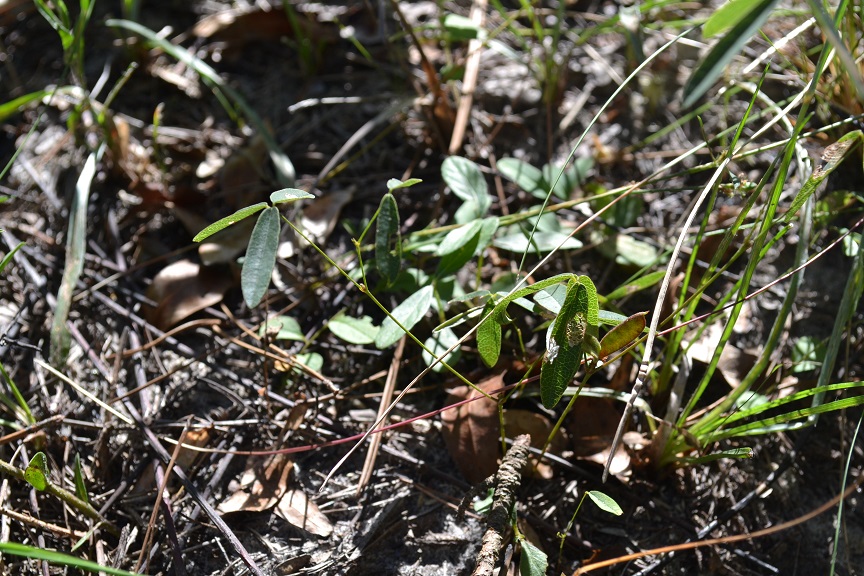Galactia erecta
| Galactia erecta | |
|---|---|

| |
| Photo taken by Kevin Robertson | |
| Scientific classification | |
| Kingdom: | Plantae |
| Division: | Magnoliophyta - Flowering plants |
| Class: | Magnoliopsida – Dicotyledons |
| Order: | Fabales |
| Family: | Fabaceae ⁄ Leguminosae |
| Genus: | Galactia |
| Species: | G. erecta |
| Binomial name | |
| Galactia erecta (Walter) Vail | |

| |
| Natural range of Galactia erecta from USDA NRCS Plants Database. | |
Common name: Erect milkpea
Contents
Taxonomic notes
Description
This plant is erect[1].
Generally, the genus Galactia are "trailing or twining, climbing, perennial, herbaceous or woody vines or erect, perennial herbs or rarely shrubs. Leaves 1-pinnate, usually 3-foliolate (or rarely 1-,5-7-,9-folilolate); leaflets entire, petiolulate, stipellate. Racemes axillary, pedunculate with few to numerous, papilionaceous flowers borne solitary or 2-several at a node, ech subtended by a bract and fusion of the 2 uppermost, with the laterals usually shorter than the uppermost and lowermost; petals usually red, purple, pink or white; stamens diadelphous or elsewhere occasionally monadelphous; ovary sessile or shortly stipitate. Legume oblong-linear to linear, few-many seeded, compressed, straight or slightly curbed, dehiscent with often laterally twisting valves."[2]
Specifically, for G. erecta species they are "erect perennial with glabrous or sparsely pubescent stems, mostly 2-4 dm tall. Leaves 3-foliolate with rachis 1-2 mm long; leaflets linear-oblong to oblong or elliptic, mostly 1.5-4 cm long, glabrous. Racemes 1-2 cm long, subsessile; flowers 1-6, on short-pubescent pedicels 1-3 mm long subtended by triangular-subulate bracts 1-1.5 mm long; bractlets triangular-to linear-subulate, 1-2 mm long. Calyx appressed short-pubescent, tube 2-3 mm long, lobes 2-3 mm long; petals pale purple to white, the standard 7-8 mm long. Legume 2-4 cm long, 5-8 mm broad, 6-10 seeded, with short-pubescent valves and sutures." [2]
Distribution
Ecology
Habitat
This species has been found in open longleaf pine-wiregrass flatwoods along gum swamps, wiregrass savannas, pine-oak upland forests, and clearings within pine flatwoods. This species does well in open light environments in dry loamy sands, drying sand, and sandy-peaty wet soils.[1]
Associated species seen growing with Galactia erecta include Pinus palustris, Pinus elliotii, Aristida stricta, Quercus species, Tephrosia florida, Aristida, Croton, Berlandiera, Asclepias, Tetragonotheca, Galactia mollis. [1]
Phenology
G. erecta has been observed to have corolla white or light yellowish flowers.[1] “A purple flowered perennial herb about 1 foot high, occurring in dry pine lands of the Coastal Plain from north Carolina to Louisana. Seeds have been recorded from stomach of a single bobwhite.”[3] It has been seen flowering from April to August with peak inflorescence in May and June.[1][4] It has been observed fruiting from June to July and in September.[1]
Seed dispersal
This species is thought to be dispersed by gravity. [5]
Fire ecology
It has been found in recently burned open scrub.[1]
Conservation and management
Cultivation and restoration
Photo Gallery
References and notes
- ↑ 1.0 1.1 1.2 1.3 1.4 1.5 1.6 Florida State University Robert K. Godfrey Herbarium database. URL: http://herbarium.bio.fsu.edu. Last accessed: June 2014. Collectors: Loran C. Anderson, John B. Nelson, R.K. Godfrey, Washington, Loran C. Anderson, Rodie White, William B. Fox, H. L. Blomquist, Sidney McDaniel, H. R. Reed, R. L. Wilbur, Samuel B. Jones, F. H. Sargent, Harry E. Ahles, J. Haesloop, and R. Kral. States and Counties: Florida: Wakulla, Jackson, Bay, Walton, Liberty, and Gadsden. Georgia: Thomas, Baker, and Dodge. North Carolina: Bladen and Onslow. Mississippi: George, McNeill, Lamar, and Pearl River. Alabama: Baldwin and Clarke.
- ↑ 2.0 2.1 Radford, Albert E., Harry E. Ahles, and C. Ritchie Bell. Manual of the Vascular Flora of the Carolinas. 1964, 1968. The University of North Carolina Press. Print.
- ↑ Graham, E. H. (1941). Legumes for erosion control and wildlife. Washington, USDA
- ↑ Nelson, G. PanFlora: Plant data for the eastern United States with emphasis on the Southeastern Coastal Plains, Florida, and the Florida Panhandle. www.gilnelson.com/PanFlora/ Accessed: 9 DEC 2016
- ↑ Kirkman, L. Katherine. Unpublished database of seed dispersal mode of plants found in Coastal Plain longleaf pine-grasslands of the Jones Ecological Research Center, Georgia.